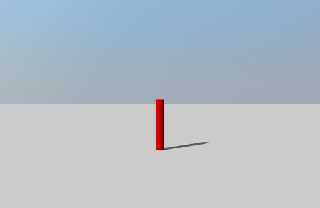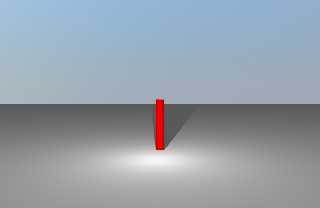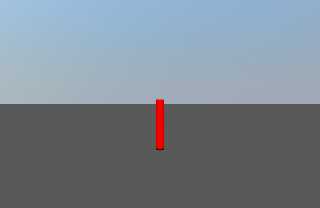 |
 |
|
 |
|
 |
|  |
|  |
|
 |
|
 |
|  |
|  |
|
 |
On 18-6-2013 10:52, scott wrote:
>> There is a much better solution.
> ...
>> The scene does not need the *emission* of the *visible* sphere as a
>> light source.
>
> As I said before, there isn't any need to try this for radiosity, it
> will just cause problems like you experienced. It's only in the code as
> it is needed for mcpov (where is works fine).
But mcpov has other problems of its own, as Clipka explained some time ago.
>
>> It only needs the light source itself. So, the solution is
>> to put the sunlight at the standard SunPos position, and the *visible*
>> sphere and its radius at sp/1000.
>
> I don't know if there are any accuracy issues related to having a
> light_source a very large distance away, I expect it may cause some
> shadow artifacts? The length of the vector from SunPos is quite
> arbitrary, so in every scene you just need to find the max distance it
> works at, then I'd probably divide by 10 or 100 just to be sure you're
> not near the accuracy limit.
I have never met any problems or artefacts when using SunPos so, imho,
there is no need to divide.
>
>> In addition, just make emission of the
>> sphere equal to 1.
>
> The problem with that is the sun will look unrealistically dim compared
> to the sky when visible in any reflections, especially darker low-level
> reflections (eg a black car). You could set emission to 0 and ambient to
> the original physically correct 1.6e9 * EXP, but I think that would
> still influence the radiosity algorithm and give you back the bright
> splotches again.
Maybe, but those are special cases needing special solutions.
>
> At this point I usually fire up mcpov :-)
<grin>
Thomas
Post a reply to this message
|
 |
|  |
|  |
|
 |
|
 |
|  |
|  |
|
 |
> But mcpov has other problems of its own, as Clipka explained some time ago.
The only major one is the diffuse values are out by a factor of 2, I
usually use a macro for setting the finish which outputs either the
vanilla POV syntax (for testing the scene) or the mcpov syntax (for
final render). Incorporating the factor of 2 correction is easy in the
macro.
> I have never met any problems or artefacts when using SunPos so, imho,
> there is no need to divide.
That's just because you never tried to put a sphere at that position
before :-) Also I haven't done a thorough investigation, but the
accuracy issues you run into seem to depend on the size of other objects
in your scene (and maybe the camera setup?). Whilst the /1000 factor for
placing the sphere might work in this particular scene, it may become
invisible again in a different scene (or work fine without the /1000).
I suppose the ultimate solution would be to incorporate the sun in the
sky_sphere pigment at the physically correct brightness (which would
save having to use any arbitrary values for "very far away"), and for
the POV team to implement something similar to the sky importance
sampling in mcpov for the radiosity algorithm (so you don't need a
really high count to reliably pick up the bright sun).
> Maybe, but those are special cases needing special solutions.
I never thought I'd hear a glossy reflective surface being called a
"special case" in a raytracing forum - what next, a checkered plane is
also a special case? :-O
>> At this point I usually fire up mcpov :-)
>
> <grin>
Bring on mcpov merged into POV 3.7 !! If I had the time I'd definitely
give it a shot.
Post a reply to this message
|
 |
|  |
|  |
|
 |
|
 |
|  |
|  |
|
 |
On 19-6-2013 16:24, scott wrote:
>> I have never met any problems or artefacts when using SunPos so, imho,
>> there is no need to divide.
>
> That's just because you never tried to put a sphere at that position
> before :-) Also I haven't done a thorough investigation, but the
> accuracy issues you run into seem to depend on the size of other objects
> in your scene (and maybe the camera setup?). Whilst the /1000 factor for
> placing the sphere might work in this particular scene, it may become
> invisible again in a different scene (or work fine without the /1000).
Oh yes, I did! ;-) However, I only use SunPos for my main light source.
I hardly use a visible sun.
>
> I suppose the ultimate solution would be to incorporate the sun in the
> sky_sphere pigment at the physically correct brightness (which would
> save having to use any arbitrary values for "very far away"), and for
> the POV team to implement something similar to the sky importance
> sampling in mcpov for the radiosity algorithm (so you don't need a
> really high count to reliably pick up the bright sun).
That would be a good idea.
>
>> Maybe, but those are special cases needing special solutions.
>
> I never thought I'd hear a glossy reflective surface being called a
> "special case" in a raytracing forum - what next, a checkered plane is
> also a special case? :-O
LOL good point. I admit that I was talking from a strictly personal
point of view...
> Bring on mcpov merged into POV 3.7 !! If I had the time I'd definitely
> give it a shot.
I am too happy with 3.7 for the things I do. ;-)
Thomas
Post a reply to this message
|
 |
|  |
|  |
|
 |
From: Thomas de Groot
Subject: Re: Sky simulation: what is wrong with this particular code?
Date: 5 Jul 2013 08:36:04
Message: <51d6bdb4@news.povray.org>
|
|
 |
|  |
|  |
|
 |
Consider the following scene code:
//start code
#version 3.7;
#include "colors.inc"
global_settings {assumed_gamma 1.0}
camera {
location <0, 5, -40>
sky y
up y
direction z*1.7
right x*image_width/image_height
angle 70
look_at <0, 5, 100>
}
#include "sunpos.inc"
#declare MySun = SunPos(2012, 3, 5, 13, 10, 0, 31.7625, 25.0888);
#declare EXP = 8e-5;
// SkySim
#include "SkySim.inc"
SkySim( SolarPosition,
y,
5,
EXP
)
#declare SunColor = rgb 1;
light_source {
MySun
color SunColor*(17334 * EXP)
//parallel
//point_at <0, 5, 100>
}
plane {y, -5 pigment {rgb 1}}
cylinder {<0,-5,10>, <0,6,10>, 1 pigment {rgb <1,0,0>}}
//end code
It renders well (see image: SkySim_SolarPosition) also with parallel and
point_at in the light_source uncommented.
Now, switch SolarPosition in the SkySim macro call, by MySun. I get
image SkySim_MySun.
Now, uncomment parrale and point_at in the light_source. I get image
SkySim_MySun parallel.
So, what is wrong here? All goes well in the original test scene.
Thomas
Post a reply to this message
Attachments:
Download 'skysim_solarposition.png' (15 KB)
Download 'skysim_mysun.png' (24 KB)
Download 'skysim_mysun parallel.png' (15 KB)
Preview of image 'skysim_solarposition.png'

Preview of image 'skysim_mysun.png'

Preview of image 'skysim_mysun parallel.png'

|
 |
|  |
|  |
|
 |
From: scott
Subject: Re: Sky simulation: what is wrong with this particular code?
Date: 5 Jul 2013 09:38:01
Message: <51d6cc39$1@news.povray.org>
|
|
 |
|  |
|  |
|
 |
On 05/07/2013 13:35, Thomas de Groot wrote:
> Consider the following scene code:
>
> //start code
> #version 3.7;
>
> #include "colors.inc"
>
> global_settings {assumed_gamma 1.0}
>
> camera {
> location <0, 5, -40>
> sky y
> up y
> direction z*1.7
> right x*image_width/image_height
> angle 70
> look_at <0, 5, 100>
> }
>
> #include "sunpos.inc"
> #declare MySun = SunPos(2012, 3, 5, 13, 10, 0, 31.7625, 25.0888);
> #declare EXP = 8e-5;
>
> // SkySim
> #include "SkySim.inc"
> SkySim( SolarPosition,
> y,
> 5,
> EXP
> )
>
> #declare SunColor = rgb 1;
>
> light_source {
> MySun
> color SunColor*(17334 * EXP)
> //parallel
> //point_at <0, 5, 100>
> }
>
>
> plane {y, -5 pigment {rgb 1}}
> cylinder {<0,-5,10>, <0,6,10>, 1 pigment {rgb <1,0,0>}}
>
> //end code
>
> It renders well (see image: SkySim_SolarPosition) also with parallel and
> point_at in the light_source uncommented.
>
> Now, switch SolarPosition in the SkySim macro call, by MySun. I get
> image SkySim_MySun.
>
> Now, uncomment parrale and point_at in the light_source. I get image
> SkySim_MySun parallel.
>
> So, what is wrong here? All goes well in the original test scene.
Hmmm ok, so apparently I misunderstood the POV syntax, this short piece
of code prints X=9 whereas I assumed it would print X=10. Not sure if
this is intended behaviour or not.
// start code
#macro A(B)
#local B = B - 1;
#end
#declare X = 10;
A(X)
#warning concat("X = ",str(X,0,0))
// end code
Will fix the macro and post and update... (it's essentially normalizing
your sun position, which you're then using the place the light source).
Post a reply to this message
|
 |
|  |
|  |
|
 |
From: Thomas de Groot
Subject: Re: Sky simulation: what is wrong with this particular code?
Date: 5 Jul 2013 10:07:42
Message: <51d6d32e$1@news.povray.org>
|
|
 |
|  |
|  |
|
 |
On 5-7-2013 15:38, scott wrote:
> Will fix the macro and post and update... (it's essentially normalizing
> your sun position, which you're then using the place the light source).
>
Thanks! Glad to be of help (by chance) :-)
Thomas
Post a reply to this message
|
 |
|  |
|  |
|
 |
From: Alain
Subject: Re: Sky simulation: what is wrong with this particular code?
Date: 5 Jul 2013 20:17:30
Message: <51d7621a$1@news.povray.org>
|
|
 |
|  |
|  |
|
 |
>
>
> Hmmm ok, so apparently I misunderstood the POV syntax, this short piece
> of code prints X=9 whereas I assumed it would print X=10. Not sure if
> this is intended behaviour or not.
>
> // start code
>
> #macro A(B)
> #local B = B - 1;
> #end
>
> #declare X = 10;
> A(X)
> #warning concat("X = ",str(X,0,0))
>
> // end code
>
> Will fix the macro and post and update... (it's essentially normalizing
> your sun position, which you're then using the place the light source).
>
Your code develop as:
#declare X = 10;
#local X = X - 1;
In this contex, #local and #declare are synonims.
So, yes, it works as expected.
There is a difference when #local is used in an include file. In an
include, any #local variables only exist within the include.
Post a reply to this message
|
 |
|  |
|  |
|
 |
From: scott
Subject: Re: Sky simulation: what is wrong with this particular code?
Date: 8 Jul 2013 03:54:52
Message: <51da704c$1@news.povray.org>
|
|
 |
|  |
|  |
|
 |
> Your code develop as:
> #declare X = 10;
> #local X = X - 1;
> In this contex, #local and #declare are synonims.
>
> So, yes, it works as expected.
>
> There is a difference when #local is used in an include file. In an
> include, any #local variables only exist within the include.
It is in an include, sorry in the above example the macro is in another
file. Try this (two files):
// file1.inc
#macro A(B)
#local B = 5;
#end
// file2.pov
#include "file1.inc"
#declare X = 10;
A(X)
#warning concat("X = ",str(X,0,0))
X comes out as 5, but I would have expected 10.
Post a reply to this message
|
 |
|  |
|  |
|
 |
From: scott
Subject: Re: Sky simulation: what is wrong with this particular code?
Date: 8 Jul 2013 08:18:23
Message: <51daae0f@news.povray.org>
|
|
 |
|  |
|  |
|
 |
While we're at it this also causes an error (even if the definition for
A is in a different file):
#macro A()
#end
#macro B()
#local A=1;
#end
B()
This one is a bit more serious as it means if any macro in your scene
uses a local variable with the same name as another macro you'll get an
error.
Post a reply to this message
|
 |
|  |
|  |
|
 |
|
 |
|  |
|  |
|
 |
scott <sco### [at] scott com> wrote:
> While we're at it this also causes an error (even if the definition for
> A is in a different file):
>
> #macro A()
> #end
> #macro B()
> #local A=1;
> #end
> B()
>
> This one is a bit more serious as it means if any macro in your scene
> uses a local variable with the same name as another macro you'll get an
> error.
This is a known problem, although I do not know that the POV Team perceives it
as a problem. When I brought it up 5 years ago, I was quoted documentation of
macro names being global in scope, which was just a red herring. This behavior
breaks the very concept of local variables and makes "black box" modularization
impossible.
You also get an error if you declare a function with an argument that has the
same name as a previously declared variable.
I hope that these (and ALL other cases of scope leakage in POV-Ray) will be
eliminated by version 4.0. com> wrote:
> While we're at it this also causes an error (even if the definition for
> A is in a different file):
>
> #macro A()
> #end
> #macro B()
> #local A=1;
> #end
> B()
>
> This one is a bit more serious as it means if any macro in your scene
> uses a local variable with the same name as another macro you'll get an
> error.
This is a known problem, although I do not know that the POV Team perceives it
as a problem. When I brought it up 5 years ago, I was quoted documentation of
macro names being global in scope, which was just a red herring. This behavior
breaks the very concept of local variables and makes "black box" modularization
impossible.
You also get an error if you declare a function with an argument that has the
same name as a previously declared variable.
I hope that these (and ALL other cases of scope leakage in POV-Ray) will be
eliminated by version 4.0.
Post a reply to this message
|
 |
|  |
|  |
|
 |
|
 |
|  |
|
 |




![]()